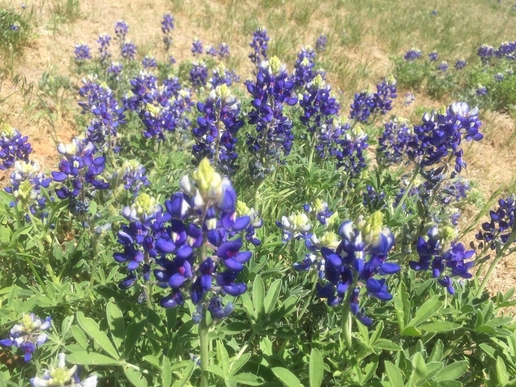by Linda Butcher
The Texas Legislature has designated 72 “official” state symbols over the years. The broad collection of favorites ranges from the beautiful blue topaz, the state gemstone to the tough prickly pear which is the state plant.
In 1901 the Texas Legislature adopted the BLUEBONNET as the state flower. Lupinus subarnosus was the species chosen. It’s also known as buffalo clover, wolf flower and el conejo. It is said that one reason it was chosen is that the beautiful blue flowers resembled the bonnets worn by the pioneer women.

While Lupinus subcarnosus species was originally chosen, it was the least attractive. In 1971, the legislature decided to combine all the lupine species that grow in Texas as the official state flower.
Although the flowers are beautiful, care should be taken if planting bluebonnets in your home landscape as the flowers are toxic to humans and pets if eaten. The most popular and widespread variety is Lupinus texensis. It prefers gravely well drained soil and full sun.
If you’re lucky when looking into a sea of bluebonnets, you might see a rare white or pink one. Legend says that while on the way to church an elderly grandmother and her two grandchildren found a white and a pink bluebonnet. She explained to the children that the white one represented the Lone Star and that some of the white ones changed to pink representing the blood that was shed at the battle of the Alamo. The pink variety continues today to stand for the battles that our ancestors fought for Texas freedom.
Texas historian Jack Maguire once wrote “The bluebonnet is to Texas as the shamrock is to Ireland and the tulip is to Holland.”
The LIGHTNING WHELK was designated as the state shell of Texas in 1987. It’s one of the largest shells in the Gulf of Mexico and can be found all along the Texas coast. Its unique shape makes it easy to recognize. The whorls coil in a counterclockwise direction with the opening on its left. This spiraling profile is shared by few other shells. On rare occasions a right- handed variety can be found.
Its common name comes from the lightning-like colored stripes that run along the side of the shell. As the shells age, the stripes fade. The thick-walled shell protects the sea snail or whelk from predators and heavy surf. As the whelk grows it adds another layer to the outer edge of the shell.

It takes 10 to 20 years to grow to normal maximum size of eight inches in length, but offshore specimens have been known to reach 16 inches. It can withdraw its soft body into its shell and close the opening with a trap door called an operculum.
Lightning Whelks are primarily carnivores. They prefer small clams and oysters.
The whelk reproduces annually. They mate during the cooler autumn months and lay their eggs in the early spring. The egg case is disc shaped and is attached to a tough cord-like string. It can contain 50 to 175 egg capsules. Each capsule contains as many as 200eggs. The eggs hatch and grow through all the larval stages within the capsules. They emerge as fully formed miniature whelks during late spring and early summer.
There are strict rules regarding collecting the live shells. You must have a valid Texas saltwater fishing license. There is a closed season for harvesting whelks as well as a few other species on South Padre Island from November 1 through April 30. To avoid any problems, check with Texas Parks and Wildlife for all rules and regulations. The local shell club discourages the collection of any live shells for conservation reasons.
The third and last symbol for this article is one of my favorites, the TEXAS HORNED LIZARD (Phrynosoma comutum). It was adopted as the state reptile in 1993. It is known by several names such as horny toad and horned frog. As the horned frog, it is the mascot of Texas Christian University in Fort Worth. It is one of about 14 North American species of spikey-bodied reptiles in the genus Phrynosoma. Its lineage can be traced back to dinosaurs. In 1977 it was put on the threatened species list.
There is good news for this little lizard. A coalition of zoos and wildlife scientists released 204captive-bred hatchlings into the wild in 2021. One hundred of them were hatched at the Fort Worth Zoo. There is also evidence that previously released lizards are now reproducing in the wild.

They can be found in arid and semi-arid habitats in open areas with sparse vegetation. They prefer loose sand or loamy soils since they dig for hibernation, nesting and insulation.
Horned lizards range from Colorado and Kansas to Northern Mexico and from Southeastern Arizona east to Texas. They have been introduced to the Carolinas, Georgia and Florida. Most records from East Texas, Louisiana and Arkansas are thought to be escaped pets and not part of the species natural range.
They feed on ants, grasshoppers, crickets, beetles and spiders. However, ants are their preferred diet.
It is a fierce looking little lizard and when threatened, it can inflate its body to frighten away its enemies. As a last resort in self defense the horned lizard can squirt blood from its eyes.
The horned lizard plays an important role in Native American cultures. It is seen as a symbol of strength and healing.

Leave a Reply